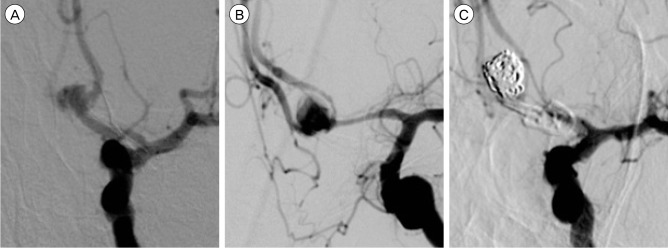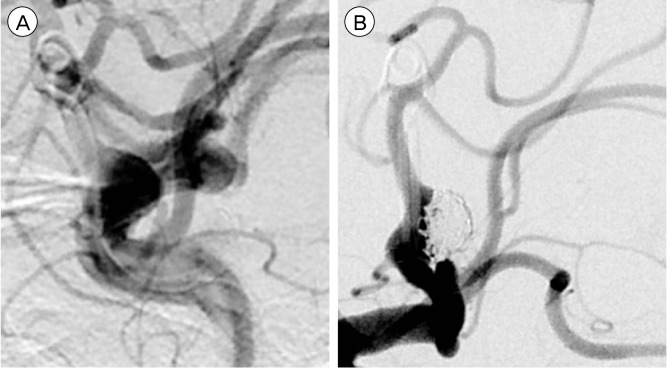J Cerebrovasc Endovasc Neurosurg.
2014 Sep;16(3):262-267. 10.7461/jcen.2014.16.3.262.
Endovascular Coil Embolization After Clipping: Endovascular Treatment of Incompletely Clipped or Recurred Cerebral Aneurysms
- Affiliations
-
- 1Department of Neurosurgery, Gyeongsang National University School of Medicine, Jinju, Korea. gnuhpis@gnu.ac.kr
- 2Gyeongsang Institute of Health Science, Jinju, Korea.
- KMID: 1963165
- DOI: http://doi.org/10.7461/jcen.2014.16.3.262
Abstract
OBJECTIVE
The presence of a cerebral aneurysm remnant after surgical clipping is associated with a risk of regrowth or rupture. For these recurred aneurysms, coil embolization can be considered as a treatment option. We retrospectively reviewed cases of ruptured or regrown aneurysms after clipping treated by endovascular coil embolization.
MATERIALS AND METHODS
We conducted a retrospective review of patients with ruptured or recurred aneurysm after clipping, who underwent coil embolization between January 1995 and December 2013. We evaluated clinical information and the outcomes of these cases.
RESULTS
Eight patients were treated by endovascular coil embolization after surgical clipping. Six aneurysms were located in the anterior communicating artery, one in the posterior communicating artery, and one in the middle cerebral artery bifurcation. All patients were initially treated by surgical clipping because of a ruptured aneurysm. Aneurysm recurrence at the initial clipping site was detected in all cases. The median interval from initial to second presentation was 42 months. In four patients, aneurysms were detected before rupture and the four remaining patients presented with recurrent subarachnoid hemorrhage. All patients were treated by coil embolization and showed successful occlusion of aneurysms without complications.
CONCLUSION
Endovascular coil embolization can be a safe and successful treatment option for recurred aneurysms after clipping.
Keyword
MeSH Terms
Figure
Reference
-
1. Campi A, Ramzi N, Molyneux AJ, Summers PE, Kerr RSC, Sneade M, et al. Retreatment of ruptured cerebral aneurysms in patients randomized by coiling or clipping in the international subarachnoid aneurysm trial (ISAT). Stroke. 2007; 5. 38(5):1538–1544. PMID: 17395870.
Article2. Cekirge HS, Islak C, Firat MM, Kocer N, Saatci I. Endovascular coil embolization of residual or recurrent aneurysms after surgical clipping. Acta Radiol. 2000; 3. 41(2):111–115. PMID: 10741780.
Article3. David CA, Vishteh AG, Spetzler RF, Lemole M, Lawton MT, Partovi S. Late angiographic follow-up review of surgically treated aneurysms. J Neurosurg. 1999; 9. 91(3):396–401. PMID: 10470813.
Article4. Drake CG, Friedman AH, Peerless SJ. Failed aneurysm surgery. Reoperation in 115 cases. J Neurosurg. 1984; 11. 61(5):848–856. PMID: 6491730.5. Drake CG, Allcock JM. Postoperative angiography and the "slipped" clip. J Neurosurg. 1973; 12. 39(6):683–689. PMID: 4759655.
Article6. Forsting M, Albert FK, Jansen O, von Kummer R, Aschoff AA, Kunze S, et al. Coil placement after clipping: endovascular treatment of incompletely clipped cerebral aneurysms. Report of two cases. J Neurosurg. 1996; 11. 85(5):966–969. PMID: 8893741.7. Molyneux A, Kerr R, Stratton I, Sandercock P, Clarke M, Shrimpton J, et al. International subarachnoid aneurysm trial (ISAT) collaborative group. International Subarachnoid Aneurysm Trial (ISAT) of neurosurgical clipping versus endovascular coiling in 2143 patients with ruptured intracranial aneurysms: a randomized trial. Lancet. 2002; 10. 360(9342):1267–1274. PMID: 12414200.
Article8. Kwon OK, Kim SH, Kwon BJ, Kang HS, Kim JH, Oh CW, et al. Endovascular treatment of wide-necked aneurysms by using two microcatheters: techniques and outcomes in 25 patients. AJNR Am J Neuroradiol. 2005; 4. 26(4):894–900. PMID: 15814940.9. Lanzino G, Murad MH, d'Urso PI, Rabinstein AA. Coil embolization versus clipping for ruptured intracranial aneurysms: a meta-analysis of prospective controlled published studies. AJNR Am J Neuroradiol. 2013; 9. 34(9):1764–1768. PMID: 23578672.
Article10. Lin T, Fox AJ, Drake CG. Regrowth of aneurysm sacs from residual neck following aneurysm clipping. J Neurosurg. 1989; 4. 70(4):556–560. PMID: 2926496.
Article11. Moon JU, Koh JS, Kim TS, Kim GK, Rhee BA, Lim YJ. Treatment of remnant aneurysms previously treated with endovascular coiling or surgical clipping. J Korean Soc Intravasc Neurosurg. 2007; 6. 2(2):41–47.12. Rabinstein AA, Nichols DA. Endovascular coil embolization of cerebral aneurysm remnants after incomplete surgical obliteration. Stroke. 2002; 7. 33(7):1809–1815. PMID: 12105358.
Article13. Takeda N, Kidoguchi K, Matsuo K, Nishihara M. Endovascular coil embolization for recurrence of intracranial aneurysms more than 10 years after clipping. Indian J Neurosurg. 2013; 2(3):271–274.
- Full Text Links
- Actions
-
Cited
- CITED
-
- Close
- Share
- Similar articles
-
- Recent Trends in the Treatment of Cerebral Aneurysms: Comparison between Endovascular Coil Embolization and Surgical Clipping
- Combined Endovascular and Microsurgical Procedures as Complementary Approaches in the Treatment of a Single Intracranial Aneurysm
- Endovascular Treatment of Cerebral Aneurysms: Technical Options in Coil Embolization
- Endovascular Treatment of Incompletely Clipped Cerebral Aneurysm
- Endovascular Treatment of Wide-Necked Intracranial Aneurysms : Techniques and Outcomes in 15 Patients



